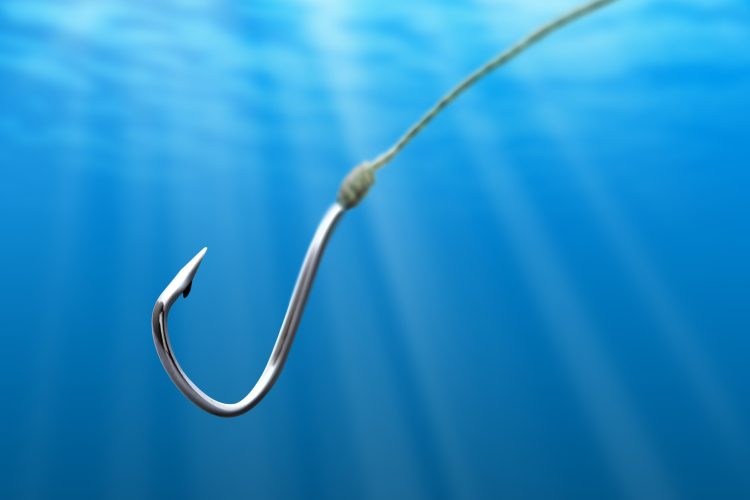When catching grouper, it is better to use 6/0 or larger hooks, typically 8/0, which is a good all-purpose size. The area must be large enough to easily bait the hook to function when a fish takes the bait. If you want to catch groupers, you will need a large hook that is strong enough to withstand the grouper’s pull and sharp enough to penetrate its skin. When fishing for groupers with smaller hooks, there is a risk that the fish may break free after being caught or before it reaches the boat, making your time on the sea useless. The best way to avoid this problem is by attaching larger hooks made of high-quality materials like stainless steel or bronze metals that are durable even under heavy pressure from a big grouper.
Hooks for Fishing Groupers
Hooks are a matter of personal preference. Circle hooks are required for grouper fishing in the Gulf of Mexico. They are frequently used by fishermen when grouper fishing. When used properly, circle hooks almost always catch the fish in the corner of the mouth. Fish mortality is decreased, and this helps with live releases.
When using circle hooks, it’s crucial not to set the hook. In most cases, fishing will be unsuccessful after setting the hook. Instead, the slack is taken up with the reel before the rod is lifted when a bite is felt with the rod’s tip held low near the water’s surface. The fish is hooked in the mouth as the hook exits the fish’s mouth, rotates, and turns almost like a can opener.
Choosing the right size circle hooks is crucial when using them. Although the hook may appear enormous, the distance between the tip and the shank is what matters. For the hook to work when a fish takes the bait, that area must be big enough to bait the hook easily. Circle hooks between 8/0 and 10/0 are a good all-purpose size.
For grouper fishing, standard short-shanked live-bait hooks are also common. These hooks must be robust and powerful. Many seasoned grouper anglers still prefer these hooks because they allow them to set the hook. Simply reeling and tightening work best in extremely deep water, as with circle hooks. A good all-purpose size for a live bait hook is 5/0. Anglers can grow larger or smaller depending on the bait’s size and the fish being pursued.
Understanding Hook Size
Various sizes and styles of hooks are available that can be used to catch anything from a minnow to a marlin. Additionally, there are numerous colors for hooks. Despite the wide variety of options, a few standard sizes and styles will probably satisfy all your freshwater and saltwater fishing needs.
The size of the fish you are trying to catch—specifically, the size of its mouth—determines the size of the hook you should use. A five-pound carp and a five-pound bass are roughly the same sizes, but the carp has a much smaller mouth, so you will need a much smaller hook to catch it.
The size of the bait you’re using on the hook should also be taken into account. Even when used to catch the same species of fish, live minnows require a larger hook than earthworms because the gap in the hook needs to be large enough to allow the minnow to move. Simply try to remember that you can catch both.
The length of the shaft and the gape—also known as the gap—between the hook’s shank and shaft—are used to determine the hook’s size. The size of the hook is indicated as a number, and up to a point, the bigger the number, the smaller the hook size.
A #6 hook with a quarter-inch gap is ideal for catching bream, while a #22 tiny hook is used for tying flies. This sizing system remains constant until you encounter a #1 hook. A 1/0, 2/0, and so on are the sizes that follow, with a 2/0 being a good size for plastic worms used to catch bass. The 10/0 hook, which is the largest, is adequate for a shark.
Size (#) and length (/) of fishing hook
The measurement of a hook is defined on a spectrum by “Sizes” and “Aughts.” “Sizes” are smaller than “Aughts,” with 1/0 (Pronounced One – Aught) representing the middle or median of the scale. A Size 10 would be on the smaller end of the spectrum, a 10/0 (Pronounced Ten-Aught) would be on the larger end, and 1/0 would be in the middle. “Sizes” are the inverse of “Aughts”; as “Size” increases, the hooks become smaller; as “Aught” increases, the hooks become larger.
Styles Of Hook
Hooks are designed for specific types of fishing and thus come in a variety of shapes. Some have a very wide gap between the point and the shaft, allowing them to be used with thick plastic worms while still leaving a small gap for the bait to fill when the hook is set on a fish. Others use barbs, distinct bends, or even small coils of wire to keep the bait in place. Hooks can be made of heavy metals or light wire, depending on the type of fish they are designed to catch.
The most widespread fishing hooks are listed below:
- Bait Hooks
- Aberdeen Hooks
- Circle Hooks
- Octopus Hooks
- Egg Hooks
- O’Shaugnessy Hooks
- Offset Shank Hooks
- Siwash Hooks
- Worm Hooks
- Weedless Hooks
Material For Hook
Most hooks are made from steel, which can range from pure iron to stainless steel. While freshwater hooks don’t need to be made from rust-resistant materials, saltwater hooks are typically made from such materials. This is due to how much slower freshwater rusts metal than saltwater. It is possible to find specific alloys that keep the hook sharp and others that give it increased strength, preventing it from bending when battling a large fish.
Conclusion
The bottom-dwelling grouper is a highly sought-after species. Grouper are prized by many anglers for their flaky white fillets, even though they are powerful fish that put up a fierce fight! The best grouper fishing is done in 120 to 180 feet of water over wrecks or hard bottoms (rocks or reefs). We also learn the correct hook size for fishing for grouper. They demand a hook size of 6/0 or 8.











